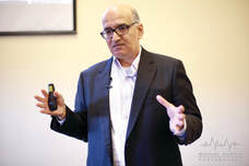 Thales Teixeira, co-founder of Decoupling and former professor at Harvard Business School. Thales Teixeira, co-founder of Decoupling and former professor at Harvard Business School. In business today, the one thing that is becoming certain is that either you will disrupt an incumbent in an industry or be a victim of disruption by an upstart sooner or later. This has been going on for a while. As Andrew Grove aptly put it with the title of his book, published in 1988, that "Only the Paranoid Survive." Today, if alive, Grove would probably title the revised edition of his book, "Only the Hyper Paranoid Thrive." The reason for this is that any incumbent can be disrupted faster than ever. Why is disruption happening so fast and often? Why is no one immune to being disrupted? I thought it was competition leveraging emerging technologies that disrupted different industries. After reading Professor Thales Teixeira's outstanding book, "Unlocking the Customer Value Chain: How decoupling drives consumer disruption," I have changed my mind. He convincingly argues that "new technology isn't driving disruptions today. Customers are." Innovation alone will not save them, but their ability to transform their business models will. Technology makes it faster for upstarts to disrupt an incumbent once the upstarts understand what activities consumers are ready to decouple in the value chain of consumption that incumbents are providing. The key concept that Professor Teixeira posits is that disruption occurs when an activity can be decoupled in the value chain of consumption. These are activities that the consumers are willing to look elsewhere to satisfy their needs and wants. To thrive today, both upstarts and incumbents must stay very close to consumers to see any signs of potential activity that they are looking to break from the value chain of consumption. Once any decoupling activity is identified, act fast. If you want to understand disruption in a refreshing way, you should get this book and study it. You will be much smarter than before in discussing disruption with business leaders. It will certainly enhance your image of being a thought leader. It may help you get ahead in your career since you will know what it takes to disrupt an incumbent or, if you work for an incumbent, see before others on ways to avoid being disrupted from upstarts. After reading the book, I had a lot of questions. Professor Teixeira was generous with his time to answer them, which I have posted below. I am spreading his ideas and message in this blog post. I thank Professor Teixeira for his generosity and time. What should you do to get familiar with Professor Teixeira's ideas of disruption?
Prof. Thales Teixeira is the co-founder of digital disruption consultancy Decoupling.co. Previously, he was the Associate Professor at Harvard Business School, where he taught for 10 years. There he has taught MBA, doctoral and executive-level courses in Marketing Models, Digital Marketing and Ecommerce. His two primary domains of research constitute Digital Disruption and The Economics of Attention. Five Questions Q: Why is it so difficult for incumbents to "decouple" the chain of consumption? Or is it that they are just paying attention to customers who are following their chain of consumption, so they don't see a potential threat to "decouple" the existing chain of consumption? Decoupling is the breaking of the links of the customer's value chain (CVC) by a digital disruptor that has been historically fully performed by incumbents companies. A recent industry that is under tremendous attack by startups performing decoupling is insurance, in all its forms. Traditionally, companies like AIG, Liberty Mutual, State Farm, and Ping An in China, have fulfilled most of the insurance shoppers' CVC. They educate customers, help them choose, sell them the policy, bill them monthly, service the policy, take and pay claims. Recently, digital startups have decided that they can better attract, educate and sell insurance to people, often using a web or mobile app environment. But interestingly, once they sell the insurance, they often pass on the customer to an incumbent insurance company to underwrite the policy and sometimes to service the policy, in effect pawning off the consumer to a traditional insurer. In doing so, startups like Lemonade, Ladder, Metromile, and Trov are in effect decoupling the insurers by "stealing" the activity of customer acquisition and sometimes customer service. In most cases, they do not create the insurance products, nor do they underwrite and handle claims. You might ask, "Why did AIG not do that themselves?" Well, I can never speak for one single company, but I have seen incumbents in manufacturing, retailing, banking, education, software, healthcare, fashion, and many other industries get decoupled. In the aggregate, what I have learned is that (a) established companies do too much and, as a consequence, cannot possibly do everything very well, and (b) established companies are too slow to adapt and change. Incumbents are like large nations. They can't be everywhere and be doing everything right. Things slip through the cracks, and their consumers get upset. Instead of quickly addressing the issue, employees of large companies take too much time or purely don't take enough interest in resolving customer pain points. So, when consumers' needs change, startups are the ones fast enough to identify them and build for those new customer needs. Going back to insurance, consumers—mostly millennials, but also other tech-savvy ones—wanted to avoid dealing with old-school insurance agents that are pushy and try to get you to buy expensive policies. These new consumers want convenience, self-service, and simplicity. That is what decouplers in insurance offer them. It has taken some time, but incumbents are now catching up. Q: Are there any examples you can cite where an incumbent was able to respond effectively to the "decoupling" threat posed by startups and how did the incumbent do it? Best Buy responded well to Amazon. Best Buy has taken a bite out of showrooming not by forcing customers to buy in-store, but rather by rebalancing its own revenue sources. Best Buy initially tried to prevent customers from showrooming (a retail form of decoupling). At first, they considered changing the barcodes on products to make them hard for shoppers to search for online. Best Buy even considered using signal jammers at their stores, like the ones they use to keep prison inmates from using cell phones. Eventually, Best Buy executives realized that Amazon and showrooming are not going away any time soon. They decided to charge manufacturers for putting those items on the shelf. When a company like Samsung puts TVs on display at Best Buy, Samsung is benefiting whether you buy it from Best Buy or Amazon. So Best Buy decided to charge for that value they create. This is what I call "preemptive decoupling" in my book. But this is extremely hard to pull off. The reality is that most incumbent companies have business models that are tightly coupled, and they need all the pieces to function together in unison to be viable. At Decoupling.co, my colleagues and I have been working with and advising companies such as Samsung, Microsoft, Hyundai, American Eagle, and many others to help them effectively respond to digital disruption and the rise of decoupling by redesigning and rebalancing their business models to be more sustainable and robust in a digital future. As in teh Best Buy case, technology is secondary. Q: Are there examples where a "decoupling" effort from startups did not succeed? Many. WeWork. Trov (the consumer app only) in insurance. One Kings Lane in furniture. Beepi in used car sales. Juicero in fruit juices. And the list goes on. The use of an innovative business model is no guarantee of success. In my research, I have identified two major causes of startup failure. First, and unsurprisingly, not acquiring enough customers is the major cause of death among startups. None of these startups that I just mentioned had this issue. But to varying degrees, they had the second one. Startups acquire enough customers as they create much value for them, but they cannot capture a sizable enough portion of said value in order to survive going forward. Monetization problems, value leakage, and limited value-capturing is the second most common reason for startup failure. My book provides a framework for detecting and "plugging in this hole." Q: Have you seen an incumbent decouple its own activities, and did it better than a startup that was trying to decouple the same activities in the chain of consumption? I am not aware of one single case and would love to get an example if any of your readers has one to share. It seems that, at least in terms of disruption by decoupling, the attackers are more motivated and apt at gaining market share than the defenders are at retaining their customers' activities. It's often a reactive process for incumbents. Q: You write about decoupling, but aren't many customers want things to be more coupled in the chain of consumption, so there is a one-stop-shop to simplify the chain of consumption? Yes, that is certainly right. I would love to have all my needs serviced by one big company instead of catering to multiple establishments. I would love to buy every food item I need at one grocery store, every news in one news media, every entertainment content with one streaming company, and every financial service with one single bank. Simplicity, convenience, lower transaction costs, are driving forces that influence the consumer into consolidation or integration. That is what I call integration forces, and they act on all of us by the urge of, as you say, "simplify the chain of consumption." Unfortunately, we also need variety, expertise, unique resources, and niche offerings. We consumers are also driven by these so-called specialized needs or "forces of specialization," as I have termed it in my book. The fact that a higher specialization force than an integration force acts on me during grocery shopping every time I go to Trader Joe's explains why, when I have time, I get my liquor in another store, or my pastries in a local bakery. The same phenomenon has made me have a bank account at Chase but have a brokerage account at Robinhood, a life insurance policy at Geico, and a stock price feed at Yahoo Finance. By offering me other benefits, in a very specialized manner, they induced me to decouple activities in my CVC that originally were fulfilled by JPMorgan Chase. Books that have influenced Professor Teixeira's thinking The Everything Store: Jeff Bezos and the Age of Amazon by Brad Stone. The Lean Startup: How Today's Entrepreneurs Use Continuous Innovation to Create Radically Successful Businesses by Eric Ries. Alibaba: The House that Jack Ma Built by Duncan Clark. The Innovator's Dilemma: When New Technologies Causes Great Firms to Fail by Clayton Christensen. #####  I am an author, speaker, executive coach. I guide people thrive on high stakes stage whether it's for a job interview, career advancement, a sales presentation or a high-stakes speech. I am the author of a practical book on speaking titled Winning Speech Moments: How to Achieve Your Objective with Anyone, Anytime, Anywhere. The main idea of the book is that if you want people to remember your speech and take action, you must create a winning speech moment. Please download the free speech checklist I created that I always use to create a winning speech for any occasion. Please contact me if you would like to thrive on high stakes stage. You can reach me at [email protected] or 732-847-9877. Note, if you are an author, executive, podcaster or very interesting to talk to and would like me to interview with five questions and then publish it as a blog post and promote it on LinkedIn, Twitter and Facebook, please contact me.
0 Comments
Leave a Reply. |
AuthorJay Oza Archives
July 2024
Categories
All
|
© 2017 Winning Speech Moments


 RSS Feed
RSS Feed